
A | B | C | D | E | F | G | H | CH | I | J | K | L | M | N | O | P | Q | R | S | T | U | V | W | X | Y | Z | 0 | 1 | 2 | 3 | 4 | 5 | 6 | 7 | 8 | 9

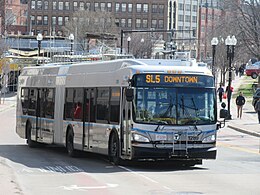
A hybrid electric vehicle (HEV) is a type of hybrid vehicle that combines a conventional internal combustion engine (ICE) system with an electric propulsion system (hybrid vehicle drivetrain). The presence of the electric powertrain is intended to achieve either better fuel economy than a conventional vehicle or better performance. There is a variety of HEV types and the degree to which each functions as an electric vehicle (EV) also varies. The most common form of HEV is the hybrid electric car, although hybrid electric trucks (pickups and tractors), buses, boats,[2] and aircraft also exist.
Modern HEVs make use of efficiency-improving technologies such as regenerative brakes which convert the vehicle's kinetic energy to electric energy, which is stored in a battery or supercapacitor. Some varieties of HEV use an internal combustion engine to turn an electrical generator, which either recharges the vehicle's batteries or directly powers its electric drive motors; this combination is known as a motor–generator.[3] Many HEVs reduce idle emissions by shutting down the engine at idle and restarting it when needed; this is known as a start-stop system. A hybrid-electric produces lower tailpipe emissions than a comparably sized gasoline car since the hybrid's gasoline engine is usually smaller than that of a gasoline-powered vehicle. If the engine is not used to drive the car directly, it can be geared to run at maximum efficiency, further improving fuel economy.
Ferdinand Porsche developed the Lohner–Porsche in 1901.[2] But hybrid electric vehicles did not become widely available until the release of the Toyota Prius in Japan in 1997, followed by the Honda Insight in 1999.[4] Initially, hybrid seemed unnecessary due to the low cost of gasoline. Worldwide increases in the price of petroleum caused many automakers to release hybrids in the late 2000s; they are now perceived as a core segment of the automotive market of the future.[5][6][better source needed]
As of April 2020[update], over 17 million hybrid electric vehicles have been sold worldwide since their inception in 1997.[7][8] Japan has the world's largest hybrid electric vehicle fleet with 7.5 million hybrids registered as of March 2018[update].[9] Japan also has the world's highest hybrid market penetration with hybrids representing 19.0% of all passenger cars on the road as of March 2018[update], both figures excluding kei cars.[9][10] As of December 2020[update], the U.S. ranked second with cumulative sales of 5.8 million units since 1999,[11] and, as of July 2020[update], Europe listed third with 3.0 million cars delivered since 2000.[12]
Global sales are led by the Toyota Motor Corporation with more than 15 million Lexus and Toyota hybrids sold as of January 2020[update],[7] followed by Honda Motor Co., Ltd. with cumulative global sales of more than 1.35 million hybrids as of June 2014[update];[13][14][15] As of September 2022[update], worldwide hybrid sales are led by the Toyota Prius liftback, with cumulative sales of 5 million units.[1] The Prius nameplate had sold more than 6 million hybrids up to January 2017.[16] Global Lexus hybrid sales achieved the 1 million unit milestone in March 2016.[17] As of January 2017[update], the conventional Prius is the all-time best-selling hybrid car in both Japan and the U.S., with sales of over 1.8 million in Japan and 1.75 million in the U.S.[16][8]
Classification
Types of powertrain
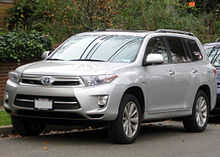

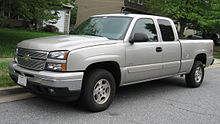
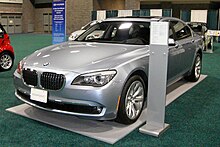
Hybrid electric vehicles can be classified according to the way in which power is supplied to the drivetrain:
- In parallel hybrids, the ICE and the electric motor are both connected to the mechanical transmission and can simultaneously transmit power to drive the wheels, usually through a conventional transmission. Honda's Integrated Motor Assist (IMA) system as found in the Insight, Civic, Accord, as well as the GM Belted Alternator/Starter (BAS Hybrid) system found in the Chevrolet Malibu hybrids are examples of production parallel hybrids.[18] The internal combustion engine of many parallel hybrids can also act as a generator for supplemental recharging. As of 2013[update], commercialized parallel hybrids use a full size combustion engine with a single, small (<20 kW) electric motor and small battery pack as the electric motor is designed to supplement the main engine, not to be the sole source of motive power from launch. But after 2015 parallel hybrids with over 50 kW are available, enabling electric driving at moderate acceleration. Parallel hybrids are more efficient than comparable non-hybrid vehicles especially during urban stop-and-go conditions where the electric motor is permitted to contribute,[18] and during highway operation.
- In series hybrids, only the electric motor drives the drivetrain, and a smaller ICE (also called range extender) works as a generator to power the electric motor or to recharge the batteries. They also usually have a larger battery pack than parallel hybrids, making them more expensive. Once the batteries are low, the small combustion engine can generate power at its optimum settings at all times, making them more efficient in extensive city driving.[18]
- Power-split hybrids have the benefits of a combination of series and parallel characteristics. As a result, they are more efficient overall, because series hybrids tend to be more efficient at lower speeds and parallel tend to be more efficient at high speeds; however, the cost of power-split hybrid is higher than a pure parallel.[18] Examples of power-split (referred to by some as "series-parallel") hybrid powertrains include 2007 models of Ford, General Motors, Lexus, Nissan, and Toyota.[18][19]
In each of the hybrids above it is common to use regenerative braking to recharge the batteries.
Type of hybridization
- Full hybrid, sometimes also called a strong hybrid, is a vehicle that can run entirely on its electric motor for a period of time.[20] Ford's hybrid system, Toyota's Hybrid Synergy Drive, Peugeot-Citroën's HYbrid4 and General Motors/Chrysler's Two-Mode Hybrid technologies are full hybrid systems.[21] The Toyota Prius, Peugeot 508 RXH HYbrid4, Ford Escape Hybrid, and Ford Fusion Hybrid are examples of full hybrids, as these cars can be moved forward on battery power alone. A large, high-capacity battery pack is needed for battery-only operation. These vehicles have a split power path allowing greater flexibility in the drivetrain by interconverting mechanical and electrical power, at some cost in complexity.
- Mild hybrid, is a vehicle that cannot be driven solely on its electric motor, because the electric motor does not have enough power to propel the vehicle on its own.[20][21] Mild hybrids include only some of the features found in hybrid technology, and usually achieve limited fuel consumption savings, up to 15 percent in urban driving and 8 to 10 percent overall cycle.[20][21] A mild hybrid is essentially a conventional vehicle with oversize starter motor, allowing the engine to be turned off whenever the car is coasting, braking, or stopped, yet restart quickly and cleanly. The motor is often mounted between the engine and transmission, taking the place of the torque converter, and is used to supply additional propulsion energy when accelerating. Accessories can continue to run on electrical power while the gasoline engine is off, and as in other hybrid designs, the motor is used for regenerative braking to recapture energy. As compared to full hybrids, mild hybrids have smaller batteries and a smaller, weaker motor/generator, which allows manufacturers to reduce cost and weight.[21] Honda's early hybrids including the first generation Insight used this design,[21] leveraging their reputation for design of small, efficient gasoline engines; their system is dubbed Integrated Motor Assist (IMA). Starting with the 2006 Civic Hybrid, the IMA system now can propel the vehicle solely on electric power during medium speed cruising. Another example is the 2005–2007 Chevrolet Silverado Hybrid, a full-size pickup truck.[21] Chevrolet was able to get a 10% improvement on the Silverado's fuel efficiency by shutting down and restarting the engine on demand and using regenerative braking. General Motors has also used its mild BAS Hybrid technology in other models such as the Saturn Vue Green Line, the Saturn Aura Greenline, the 2008-2009 Chevrolet Malibu Hybrid and the 2013–2014 Chevrolet Malibu Eco.[21]
Plug-in hybrids (PHEVs)

A plug-in hybrid electric vehicle (PHEV), also known as a plug-in hybrid, is a hybrid electric vehicle with rechargeable batteries that can be restored to full charge by connecting a plug to an external electric powersource. A PHEV shares the characteristics of both a conventional hybrid electric vehicle, having an electric motor and an internal combustion engine; and of an all-electric vehicle, also having a plug to connect to the electrical grid. PHEVs have a much larger all-electric range as compared to conventional gasoline-electric hybrids, and also eliminate the "range anxiety" associated with all-electric vehicles, because the combustion engine works as a backup when the batteries are depleted.[20][22][23]
Flex-fuel hybrid
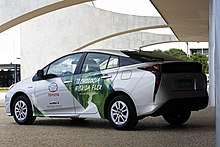
In December 2018, Toyota do Brasil announced the development of the world's first commercial hybrid electric car with flex-fuel engine capable of running with electricity and ethanol fuel or gasoline. The flexible fuel hybrid technology was developed in partnership with several Brazilian federal universities, and a prototype was tested for six months using a Toyota Prius as development mule.[24] Toyota announced plans to start series production of a flex hybrid electric car for the Brazilian market in the second half of 2019.[24][25]
The twelfth generation of the Corolla line-up was launched in Brazil in September 2019, which included an Altis trim with the first version of a flex-fuel hybrid powered by a 1.8-litre Atkinson engine.[26] By February 2020, sales of the Corolla Altis flex-fuel hybrid represented almost 25% of all Corolla sales in the country.[27]
Energy Management Systems
To take advantage of the emission reduction potential of hybrid electric vehicles (HEVs), appropriate design of their energy management systems (EMSs) to control the power flow between the engine and the battery is essential.[28]
In a conventional (non-hybrid) vehicle, there is no need for an energy management strategy: the driver decides the instant power delivery using the brake and accelerator pedals and, in manual transmission vehicles, decides which gear is engaged at any time. In a hybrid vehicle, on the other hand, there is an additional decision that must be taken due to its ability to recover energy during braking or driving downhill: how much power is delivered by each of the energy sources on-board of the vehicle. The recovered energy can be stored in the battery and deployed at a later time to assist the prime mover to provide tractive power. This is why all hybrid vehicles include an energy management controller, interposed between the driver and the component controllers. As mentioned, the aim of the energy management system is to determine the optimal power split between the on-board energy sources. The decision regarding what to consider optimal depends on the specific application: in most cases, the strategies tend to minimize the fuel consumption, but optimization objectives could also include the minimization of pollutant emissions, maximization of battery life or—in general—a compromise among all the above goals.[29]
History
Early days
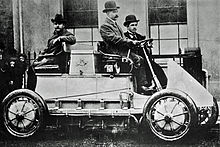
William H. Patton filed a patent application for a gasoline-electric hybrid rail-car propulsion system in early 1889, and for a similar hybrid boat propulsion system in mid-1889.[30][31] He went on to test and market the Patton Motor Car, a gas-electric hybrid system used to drive tram cars and small locomotives. A gasoline engine drove a generator that served to charge a lead acid battery in parallel with the traction motors. A conventional series-parallel controller was used for the traction motors. A prototype was built in 1889, an experimental tram car was run in Pullman, Illinois, in 1891, and a production locomotive was sold to a street railway company in Cedar Falls, Iowa, in 1897.[32][33]
In 1896, the Armstrong Phaeton was developed by Harry E. Dey and built by the Armstrong Company of Bridgeport, CT for the Roger Mechanical Carriage Company. Though there were steam, electric, and internal combustion vehicles introduced in the early days, the Armstrong Phaeton was innovative with many firsts. Not only did it have a gasoline powered 6.5-liter, two-cylinder engine, but also a dynamo flywheel connected to an onboard battery. The dynamo and regenerative braking were used to charge the battery. Its electric starter was used 16 years before Cadillac's. The dynamo also provided ignition spark and powered the electric lamps. The Phaeton also had the first semi-automatic transmission (no manual clutch). The exhaust system was an integrated structural component of the vehicle. The Armstrong Phaeton's motor was too powerful; the torque damaged the carriage wheels repeatedly.[34]
In 1900, while employed at Lohner Coach Factory, Ferdinand Porsche developed the Mixte,[2][35] a 4WD series-hybrid version of "System Lohner–Porsche" electric carriage that previously appeared in 1900 Paris World Fair.[2][36] George Fischer sold hybrid buses to England in 1901; Knight Neftal produced a racing hybrid in 1902.[37]
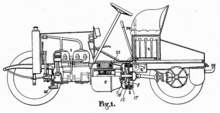
In 1905, Henri Pieper of Germany/Belgium introduced a hybrid vehicle with an electric motor/generator, batteries, and a small gasoline engine. It used the electric motor to charge its batteries at cruise speed and used both motors to accelerate or climb a hill. The Pieper factory was taken over by Impéria, after Pieper died.[38] The 1915 Dual Power, made by the Woods Motor Vehicle electric car maker, had a four-cylinder ICE and an electric motor. Below 15 mph (24 km/h) the electric motor alone drove the vehicle, drawing power from a battery pack, and above this speed the "main" engine cut in to take the car up to its 35 mph (56 km/h) top speed. About 600 were made up to 1918.[39] The Woods hybrid was a commercial failure, proving to be too slow for its price, and too difficult to service. In England, the prototype Lanchester petrol-electric car was made in 1927. It was not a success, but the vehicle is on display in Thinktank, Birmingham Science Museum.[40][41] The United States Army's 1928 Experimental Motorized Force tested a gasoline-electric bus in a truck convoy.[citation needed]
In 1931, Erich Gaichen invented and drove from Altenburg to Berlin a 1/2 horsepower electric car containing features later incorporated into hybrid cars. Its maximum speed was 25 miles per hour (40 km/h), but it was licensed by the Motor Transport Office, taxed by the German Revenue Department and patented by the German Reichs-Patent Amt. The car battery was re-charged by the motor when the car went downhill. Additional power to charge the battery was provided by a cylinder of compressed air which was re-charged by small air pumps activated by vibrations of the chassis and the brakes and by igniting oxyhydrogen gas. No production beyond the prototype was reported.[citation needed]

During the Second World War, Ferdinand Porsche sought to use his firm's experience in hybrid drivetrain design for powering armored fighting vehicles for Nazi Germany. A series of designs, starting with the VK 3001 (P), the unsuccessful VK 4501 (P) heavy tank prototype (which became the Elefant tank destroyer) and concluding with the heaviest armored fighting vehicle ever prototyped, the Panzerkampfwagen Maus of nearly 190 tonnes in weight, were just two examples of a number of planned Wehrmacht "weapons systems" (including the highly-"electrified" subsystems on the Fw 191 bomber project), crippled in their development by the then-substandard supplies of electrical-grade copper, required for the electric final drives on Porsche's armored fighting vehicle powertrain designs.[citation needed]
Predecessors of present technology
The regenerative braking system, a core design concept of most modern production HEVs, was developed in 1967 for the American Motors Amitron and called Energy Regeneration Brake by AMC.[42] This completely battery powered urban concept car was recharged by braking, thus increasing the range of the automobile.[43] The AMC Amitron was first use of regenerative braking technology in the U.S.[44]
A more recent working prototype of the HEV was built by Victor Wouk (one of the scientists involved with the Henney Kilowatt, the first transistor-based electric car) and Dr. Charles L Rosen. Wouk's work with HEVs in the 1960s and 1970s earned him the title as the "Godfather of the Hybrid".[45] They installed a prototype hybrid drivetrain (with a 16-kilowatt (21 hp) electric motor) into a 1972 Buick Skylark provided by GM for the 1970 Federal Clean Car Incentive Program, but the program was stopped by the United States Environmental Protection Agency (EPA) in 1976 while Eric Stork, the head of the EPA's vehicle emissions control program at the time, was accused of a prejudicial coverup.[46]
In 1979 the Fiat 131 Ibrido was presented in Detroit,[47][48] a marching prototype made by the CRF (Fiat Research Center). The engine compartment was composed by the 903cc borrowed from the Fiat 127, set to output 33 hp only and coupled to a 20 kW electric motor. The scheme proposed by Fiat is defined as "parallel hybrid": the petrol engine is connected to the differential with a 1:1 direct gear ratio, without gearbox, instead of the clutch there was an 8-inch torque converter followed by the transmission shaft on which the rotor of the electric motor is keyed, the latter powered by a 12-batteries pack.
The regenerative brake concept was further developed in the early 1980s by David Arthurs, an electrical engineer, using off-the shelf components, military surplus, and an Opel GT.[49] The voltage controller to link the batteries, motor (a jet-engine starter motor), and DC generator was Arthurs'. The vehicle exhibited 75 miles per US gallon (3.1 L/100 km; 90 mpg‑imp) fuel efficiency, and plans for it were marketed by Mother Earth News.[50]
In 1982, Fritz Karl Preikschat invented an electric propulsion and braking system for cars based on regenerative braking.[51] While clearly not the only patent relating to the hybrid electric vehicle, the patent was important based on 120+ subsequent patents directly citing it.[51] The patent was issued in the U.S. and the system was not prototyped or commercialized.
In 1988, Alfa Romeo built three prototypes of the Alfa 33 Hybrid,[52] equipped with the tried and tested Alfasud boxer engine (1,500cc, 95 HP) combined with a three-phase asynchronous electric motor (16 HP, 6.1 kgm of torque) supplied by Ansaldo of Genoa. The design was realistic and already mass production-oriented, with minimal modifications to the standard body and a weight increase of only 150 kg (110 for the batteries, 20 for the electric engine and 10 for power electronics). The Alfa Romeo 33 Ibrida was able to travel up to 60 km/h in full electric mode, with a 5 km range, very good performance for the time.
In 1989, Audi produced its first iteration of the Audi Duo (the Audi C3 100 Avant Duo) experimental vehicle, a plug-in parallel hybrid based on the Audi 100 Avant quattro. This car had a 9.4 kilowatts (12.8 PS; 12.6 bhp) Siemens electric motor which drove the rear roadwheels. A trunk-mounted nickel–cadmium battery supplied energy to the motor that drove the rear wheels. The vehicle's front roadwheels were powered by a 2.3-litre five-cylinder petrol engine with an output of 100 kilowatts (136 PS; 134 bhp). The intent was to produce a vehicle which could operate on the engine in the country, and electric mode in the city. Mode of operation could be selected by the driver. Just ten vehicles are believed to have been made; one drawback was that due to the extra weight of the electric drive, the vehicles were less efficient when running on their engines alone than standard Audi 100s with the same engine.[citation needed]
Two years later, Audi, unveiled the second duo generation, the Audi 100 Duo – likewise based on the Audi 100 Avant quattro. Once again, this featured an electric motor, a 21.3 kilowatts (29.0 PS; 28.6 bhp) three-phase machine, driving the rear roadwheels. This time, however, the rear wheels were additionally powered via the Torsen centre differential from the main engine compartment, which housed a 2.0-litre four-cylinder engine.[citation needed]
Research and Development was advancing in the 1990s with projects such as the early BMW 5 Series (E34) CVT hybrid-electric vehicle [53] In 1992, Volvo ECC was developed by Volvo. The Volvo ECC was built on the Volvo 850 platform. In contrast to most production hybrids, which use a gasoline piston engine to provide additional acceleration and to recharge the battery storage, the Volvo ECC used a gas turbine engine to drive the generator for recharging.
The Clinton administration initiated the Partnership for a New Generation of Vehicles (PNGV) program on 29 September 1993, that involved Chrysler, Ford, General Motors, USCAR, the DoE, and other various governmental agencies to engineer the next efficient and clean vehicle.[54] The United States National Research Council (USNRC) cited automakers' moves to produce HEVs as evidence that technologies developed under PNGV were being rapidly adopted on production lines, as called for under Goal 2. Based on information received from automakers, NRC reviewers questioned whether the "Big Three" would be able to move from the concept phase to cost effective, pre-production prototype vehicles by 2004, as set out in Goal 3.[55] The program was replaced by the hydrogen-focused FreedomCAR initiative by the George W. Bush administration in 2001,[56] an initiative to fund research too risky for the private sector to engage in, with the long-term goal of developing effectively carbon emission- and petroleum-free vehicles.
1998 saw the Esparante GTR-Q9 became the first Petrol-Electric Hybrid to race at Le Mans, although the car failed to qualify for the main event. The car managed to finished second in class at Petit Le Mans the same year.
Zdroj:https://en.wikipedia.org?pojem=Hybrid_modeText je dostupný za podmienok Creative Commons Attribution/Share-Alike License 3.0 Unported; prípadne za ďalších podmienok. Podrobnejšie informácie nájdete na stránke Podmienky použitia.
Antropológia
Aplikované vedy
Bibliometria
Dejiny vedy
Encyklopédie
Filozofia vedy
Forenzné vedy
Humanitné vedy
Knižničná veda
Kryogenika
Kryptológia
Kulturológia
Literárna veda
Medzidisciplinárne oblasti
Metódy kvantitatívnej analýzy
Metavedy
Metodika
Text je dostupný za podmienok Creative
Commons Attribution/Share-Alike License 3.0 Unported; prípadne za ďalších
podmienok.
Podrobnejšie informácie nájdete na stránke Podmienky
použitia.
www.astronomia.sk | www.biologia.sk | www.botanika.sk | www.dejiny.sk | www.economy.sk | www.elektrotechnika.sk | www.estetika.sk | www.farmakologia.sk | www.filozofia.sk | Fyzika | www.futurologia.sk | www.genetika.sk | www.chemia.sk | www.lingvistika.sk | www.politologia.sk | www.psychologia.sk | www.sexuologia.sk | www.sociologia.sk | www.veda.sk I www.zoologia.sk
